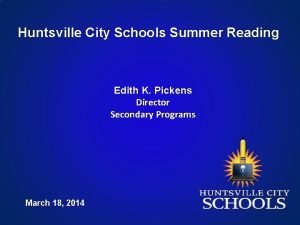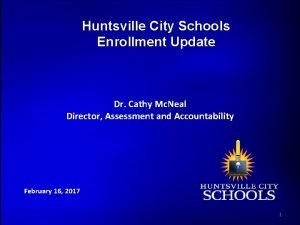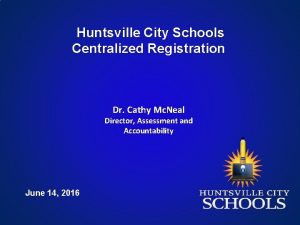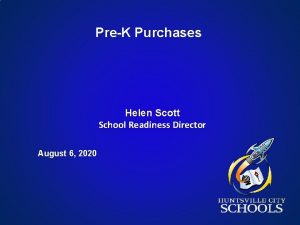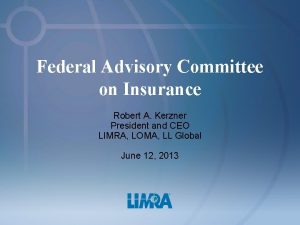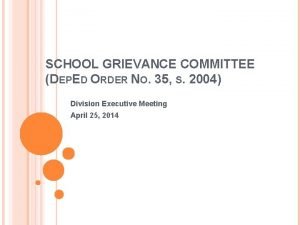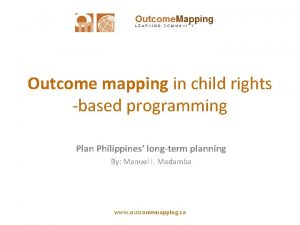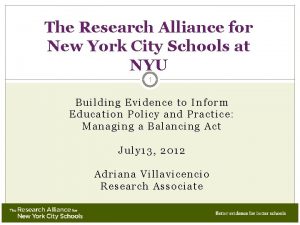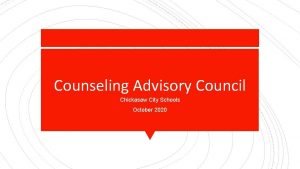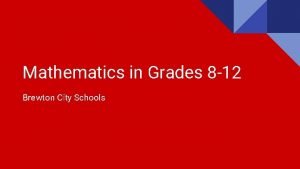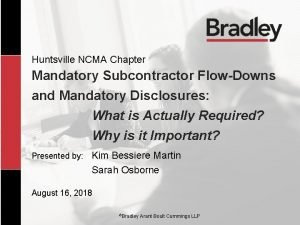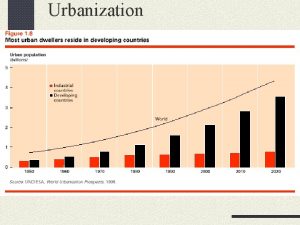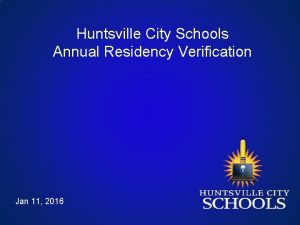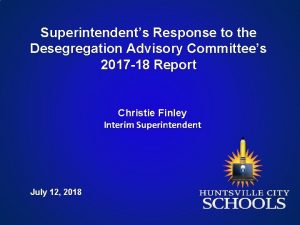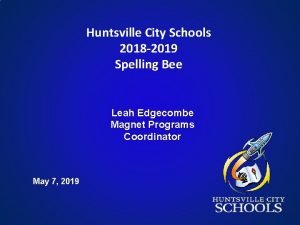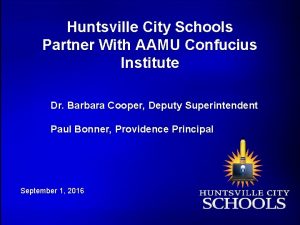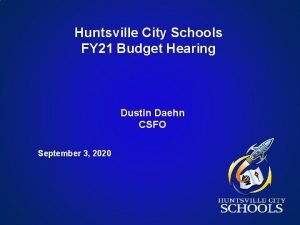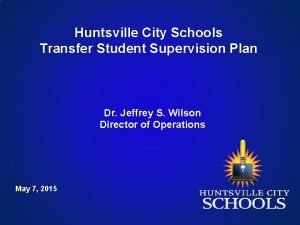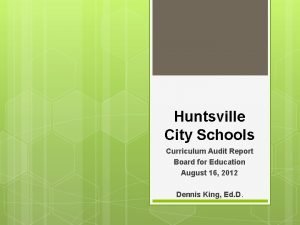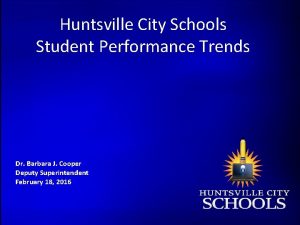Huntsville City Schools Desegregation Advisory Committee DAC Annual








































- Slides: 40

Huntsville City Schools Desegregation Advisory Committee (DAC) Annual Report Dr. Casey Wardynski July 14, 2016

2015 -16 Desegregation Advisory Committee (DAC) • • • Melissa Thompson – 2 year term Chaundra Jones – 2 year term Talya Hargrove – 2 year term Isha Greene – 2 year term Ann Kvach – 1 year term Troy Garner – 1 year term Keith Poe – 1 year term Laura Lemley – 1 year term Nicole Balthazaar – 1 year term Natalie Murrell – 1 year term Paige Davis – Johnson High School Ashley Lopez – Grissom High School 2

2016 -17 Desegregation Advisory Committee (DAC) • • • Vincent Argentina Kimberly Flint Preeti Francis Isha Greene Talya Hargrove Chaundra Jones Laura Lemley Keith Poe Ashley Sparks Millie Steber Oshea Beckford – Student representative from Lee High Malik Williams – Student representative from Jemison High Note: All parent members will serve two year terms. Student members serve a one year term. 3

The 2015 -16 DAC Held Multiple Meetings to Gather Information for Their Annual Report • The DAC met approximately once per month to hold non-public meetings. • The DAC held two non-public meetings with the superintendent. • The DAC held three public meetings in which stakeholders were invited to make comments. Public meetings were held: – October 26, 2015 – April 5, 2016 – May 3, 2016 • The DAC received comments orally and in writing at the public meetings. • The DAC also collected comments through the Consent Order webpage on the HCS website. • The Desegregation Advisory Committee (DAC) met with the superintendent on May 31, 2016 to provide their annual report. 4

DAC Recommendation on Student Assignment, Attendance Zones and Feeder Patterns In elementary schools that have seen a significant increase in enrollment as a result of the Consent Order, the District needs to evaluate how to more effectively manage situations in which a large number of students are together at once (i. e. physical education classes, recess, and lunch room). Many of the concerns heard regarding discipline issues at the elementary level seemed to have occurred outside of the regular classroom. 5

Superintendent Commentary on Student Assignment, Attendance Zones and Feeder Patterns Recommendation Administrative staff will review the location of disciplinary incidents, the extent to which disciplinary incidents take place outside of the traditional classroom setting, and if a determination is made that incidents are more likely to occur outside of the classroom, determine the measures that can be taken to alleviate the issue. 6

The DAC Included Stakeholder Feedback on Student Assignment, Attendance Zones and Feeder Patterns Stakeholder Feedback Topic Superintendent Response Request for information about changes to student enrollment and capacity Administrative staff will review the location of disciplinary incidents, the extent to which disciplinary incidents take place outside of the traditional classroom setting, and if a determination is made that incidents are more likely to occur outside of the classroom, determine the measures that can be taken to alleviate the issue. Parents request additional grandfathering. I am sympathetic to parent concerns about grandfathering. However, the joint Consent Order provides sufficient grandfathering to address immediate concerns regarding 201516 zone line changes. Students have made the school transitions during the previous school year. I do not recommend additional changes that would impact student assignment zones, such as additional grandfathering. 7

The DAC Included Stakeholder Feedback on Student Assignment, Majority-to-Minority Transfers Stakeholder Feedback Topic Superintendent Response Parents request information on how M-to-M transfers apply to special needs children. The District will update the FAQ on the Consent Order implementation page to address applications for Majority-to-Minority transfers for special needs students. We will ensure this information is available at community meetings that are conducted regarding the M-to-M application process. Teacher feedback received regarding student I completely agree that teachers should be transfers for children of employees. allowed transfers of their children to the school where they teach when space is available. However, I also believe it is important to comply with the provisions of the Consent Order to provide priority to Majority-to-Minority transfers, which at times does not allow for additional space for other transfers. 8

DAC Recommendation on Student Assignment, Magnet To protect the ongoing viability of the magnet programs, the DAC recommends that the parties and the Court consider expanding the retention provision found in Section II. E. 6 of the Consent Order to all magnet students (not just those in grades 6 and up) in order to preserve access and availability to the students who can be best served by theme integrated in the magnet. 9

Superintendent Commentary on Student Assignment, Magnet Accessible magnet themes and programs are important to me and to the District. In any action we take, we want to be careful not to diminish the accessibility of our magnet programs because such programs provide unique opportunities for students to excel in areas of their personal interests. However, I will see that the District discusses the DAC recommendation with the Department of Justice. The District will need to gather information and data from local schools and stakeholders before making concrete recommendations. 10

The DAC Included Stakeholder Feedback on Student Assignment, Magnet Stakeholder Feedback Topic Superintendent Response Stakeholder concern that culture of magnet schools has changed as a result of lottery protocol Accessible magnet themes and programs are important to me and to the District. In any action we take, we want to be careful not to diminish the accessibility of our magnet programs because such programs provide unique opportunities for students to excel in areas of their personal interests. However, I will see that the District discusses the DAC recommendation with the Department of Justice. The District will need to gather information and data from local schools and stakeholders before making concrete recommendations. Stakeholder request for clarification on how magnet students can lose magnet placement and return to home school 11

DAC Recommendation on Equitable Access to Course Offerings, Elementary Gifted Programs The District needs to improve transparency and communication regarding the GATE Program to ensure that parents have information they need to understand how their students will be affected. Some suggestions include (a) making the information about the GATE program more prominent on the website, (b) providing clear information about the criteria for qualification, qualification process and timelines, and appeal procedures, and (c) ensuring that all elementary schools are sharing this information with parents in a timely and accurate manner. 12

Superintendent Commentary on Equitable Access to Course Offerings, Elementary Gifted Programs The Gifted identification process has been updated to reflect the requirements of the Consent Order. The Gifted Coordinator held local parent meetings as described below: Date 8/11/2015 8/12/2015 8/13/2015 8/17/2015 8/18/2015 8/20/2015 8/24/2015 8/25/2015 8/27/2015 9/2/2015 9/3/2015 9/8/2015 9/9/2015 9/10/2015 9/14/2015 9/15/2015 9/16/2015 9/22/2015 9/23/2015 Location AAA P-8 Morris Elementary Williams Elementary Mt. Gap P-8 Weatherly Elementary Monte Sano Elementary Challenger Elementary Highlands Elementary ASFL P-8 Chapman P-8 Goldsmith Schiffman Elementary Chaffee Elementary Blossomwood Elementary Farley Elementary Lakewood Elementary Dawson Elementary Jones Valley Elementary Mc. Donnell Elementary MLK Elementary Rolling Hills Elementary Montview Elementary Providence Elementary 9/28/2015 Hampton Cove Elementary 8/31/2015 9/1/2015 (Continued on next slide. ) Approx. # in Attendance 26 11 24 15 24 21 55 2 20 15 31 9 28 40 4 2 29 7 6 2 2 25 17 13

Superintendent Commentary on Equitable Access to Course Offerings, Elementary Gifted Programs In addition, the process was publicly reviewed at the June 4, 2015 HCS Board meeting. The gifted identification process is explained at the Gifted and Talented webpage on the District’s website. We will continue to determine ways to communicate with parents about the gifted program and student identification. 14

The DAC Included Stakeholder Feedback on Equitable Access to Course Offerings, Elementary Gifted Programs Stakeholder Feedback Topic Superintendent Response Stakeholder feedback that some parents have The Gifted identification process has been not been informed of gifted selection criteria updated to reflect the requirements of the Consent Order. The Gifted Coordinator held local parent meetings at elementary schools as noted on a previous slide. In addition, the process was publicly reviewed at the June 4, 2015 HCS Board meeting. The gifted identification process is explained at the Gifted and Talented webpage on the District’s website. We will continue to determine ways to communicate with parents about the gifted program and student identification. 15

DAC Recommendations on Equitable Access to Course Offerings, Mathematics Acceleration • The Mathematics Acceleration portion of the Consent Order is underway; however, the next step is to ensure more communication to notify parents of these changes and the implications thereof, but also to enable them to make more informed choices for their children. • The Math Course Progression, found in the High School Course Description Guide and set forth below, should be updated to reflect the course sequence options beginning in 5 th grade. This information will help parents and students make more informed choices about their course selections that will have implications in high school and beyond. 16

Superintendent Commentary on Equitable Access to Course Offerings, Mathematics Acceleration I believe it is important to increase opportunities for parents to learn about math acceleration to enable them to make more informed choices for their children. District leaders will take measures to communicate a flow chart for math progression for grades five through eight that aligns with the high school math flow chart. Additional communication measures regarding math acceleration in elementary and middle grades will be implemented by District leaders. 17

DAC Recommendations on Equitable Access to Course Offerings; Honors, AP and IB Courses in Secondary Schools The District needs to ensure that the rigor and coursework required for AP classes is not compromised in an effort to increase AP participation. Adequate supports should be put into place to assist students who may need the extra help to meet the requirements of the AP courses, while maintaining the advanced level of instruction and workload needed to adequately prepare students for the AP tests. 18

Superintendent Commentary on Equitable Access to Course Offerings; Honors, AP and IB Courses in Secondary Schools Participation in AP and honors courses has increased. This results from our efforts to identify students who have potential to succeed and to provide bridge supports to our students as necessary. The College Board sets the rigor requirements for AP courses, and the District is bound by those requirements. This gives us confidence that the courses are rigorous regardless of enrollment. Teachers must submit the course syllabus for approval by the College Board for a course to have the AP designation. District instructional leaders will ensure all AP course syllabi have been approved by the College Board annually. 19

DAC Included Stakeholder Feedback on Equitable Access to Course Offerings; Honors, AP and IB Courses in Secondary Schools Stakeholder Feedback Topic Superintendent Response • Parent concern that AP teachers pressured to “loosen” standards • Parent concern that rigor in AP classes sacrificed to make AP classes more accessible • Parent concern that as AP classes have increased, number of Honors classes has decreased Participation in AP and honors courses has increased. This results from our efforts to identify students who have potential to succeed and to provide bridge supports to our students as necessary. The College Board sets the rigor requirements for AP courses, and the District is bound by those requirements. This gives us confidence that the courses are rigorous regardless of enrollment. Teachers must submit the course syllabus for approval by the College Board for a course to have the AP designation. District instructional leaders will ensure all AP course syllabi have been approved by the College Board annually. 20

DAC Recommendation on Extracurricular Activities The District needs to evaluate how to make extra-curricular activities accessible to more students by addressing factors like transportation barriers and the need for alternate meeting times. 21

Superintendent Commentary on Extracurricular Activities Given all of the costs associated with programmatic and other improvements, the District simply cannot expand the transportation budget for extracurricular activities. Those improvements total approximately $5, 000, and approximately $1, 000 of that stems from new transportation costs. However, the District can and will explore alternate meeting times. 22

The DAC Included Stakeholder Feedback on Extracurricular Activities Stakeholder Feedback Topic Superintendent Response Stakeholder concerns that distance from home to school creates barriers for involvement in extracurricular activities Given all of the costs associated with programmatic and other improvements, the District simply cannot expand the transportation budget for extracurricular activities. Those improvements total approximately $5, 000, and approximately $1, 000 of that stems from new transportation costs. However, the District can and will explore alternate meeting times. 23

The DAC Included Stakeholder Feedback on Faculty; Recruiting, Hiring and Promotion Stakeholder Feedback Topic Superintendent Response Stakeholders inquired about selection process of committees involved in hiring, fairness of process, and whether all certified staff are considered I do not understand the nature of the concerns because they are not stated in the feedback. I have no basis for suggesting that the selection process is not fair. Typically, principals recommend employees for consideration for various committees. Employees may, and on occasion have, request a recommendation from their principal. The development of committees includes consideration to ensure committees are racially diverse. Other factors may include subject matter expertise, when appropriate, and representation from various schools. A presentation was made at the June 14, 2016 HCS Board meeting to outline these procedures. The procedures are aligned to ensure we have highly effective teachers on 24 all committees.

The DAC Included Stakeholder Feedback on Faculty; Assignment Stakeholder Feedback Topic Superintendent Response • Stakeholder expressed concern about frequent moving of teachers and administrators • Stakeholder expressed concern that assignment policies and procedures resulted in retention problems with seasoned teachers When I began as Huntsville’s Superintendent, many schools had struggling principals and racially identifiable staffs, and, to correct this problem, I developed a system of teacher and administrator assignment that ensured the demographics of school staff was representative of the District average. The objectives of this process were twofold: 1) make sure that schools had diverse and effective leaders and teaching staff and 2) ensure these populations meet the District’s academic goals for students. These goals have been achieved: all of our schools have a diverse adult population and the graduation rate for each high school now exceeds the state graduation rate. (Continued on next slide. ) 25

The DAC Included Stakeholder Feedback on Faculty; Assignment Stakeholder Feedback Topic Superintendent Response Continued • Stakeholder expressed concern about frequent moving of teachers and administrators • Stakeholder expressed concern that assignment policies and procedures resulted in retention problems with seasoned teachers In recent years, administrator and teacher placement decisions have been made to match experience and expertise with school needs. District leaders continually evaluate teaching and leadership needs within schools to make recommendations regarding school placement of employees. As school needs evolve, administrator placement may also need to evolve. We consider Consent Order requirements when placing administrators. Developing and promoting employees is part of advancement and career development. Principals move toward more complex schools as their skills develop. (Continued on next slide. ) 26

The DAC Included Stakeholder Feedback on Faculty; Assignment Stakeholder Feedback Topic Superintendent Response Continued • Stakeholder expressed concern about frequent moving of teachers and administrators • Stakeholder expressed concern that assignment policies and procedures resulted in retention problems with seasoned teachers Nationally, recruiting and retaining teachers continues to be an area of concern for K-12 schools. The District is focused on efforts to retain an effective staff in all areas. I have implemented initiatives to encourage teachers to work in areas that are sometimes considered “hard to fill. ” For example, it is difficult to recruit and retain teachers in certain subject areas such as math and science. Therefore, the Board and I implemented stipends and additional training opportunities for math and science teachers to encourage excellent teachers in these areas to stay in the profession. In addition, stipends have been added to support retaining outstanding teachers in Title I schools. I have and will continue to lead the District in creating multiple opportunities for teachers to grow professionally, seek leadership positions, and receive stipends for extra assignment to encourage excellent teachers to stay in Huntsville City Schools. 27

DAC Recommendations for Student Discipline, Positive School Climate, and Effective Classroom Management; Student Code of Conduct and Positive School Climate • The District needs to expand the communication regarding use of the Anonymous Tip Line so that students, parents, and teachers can report what is taking place in the schools, such as bullying or harassment in all forms. • The District needs to provide more communication to students and parents about resources available to them to address problems they are having in the classroom or in the school. • The District needs to ensure proper time for training of administrators, teachers, staff, and bus drivers on the requirement of the new Behavioral Learning Guides before the 2016 -2017 school year begins. To ensure consistency among schools, this training needs to be done directly, to the extent possible, and not through the use of the train-the-trainer approach. • The District needs to coordinate informational meetings for parents about the requirements of the Behavioral Learning Guides and about the implementation of the app. 28

Superintendent Commentary on Student Discipline, Positive School Climate, and Effective Classroom Management; Student Code of Conduct and Positive School Climate During the 2015 -16 school year, I received feedback about the District’s implementation of the student discipline provisions of the Consent Order that was similar to the feedback contained in the DAC Annual Report. In order to address these issues, to support our teachers, and to ensure good faith implementation of the Consent Order, I developed a plan to improve our disciplinary procedures for the 2016 -17 school year. First, I commissioned a team of teachers and principals to draft a document to replace the Code of Student Conduct. The team created the Behavioral Learning Guide (“BLG”). The BLG provides guidance and support to teachers and principals. It sets clear expectations for school staff in their handling of student discipline. (Continued on next slide. ) 29

Superintendent Commentary on Student Discipline, Positive School Climate, and Effective Classroom Management; Student Code of Conduct and Positive School Climate Second, I created a new District-level support system for schools called the Behavioral Learning Network. This network will coordinate additional interventions to assist schools in supporting the students with the most significant behavioral needs. Third, I established Behavioral Learning Liaisons at each school. These classroom teachers will meet with the Director of Behavioral Learning each month. At these meetings, the Liaisons can share strategies for and concerns about the implementation of the BLG at their schools. The District will use this information to support its schools during 2016 -17 school year. For their efforts, the District is providing them a stipend. (Continued on next slide. ) 30

Superintendent Commentary on Student Discipline, Positive School Climate, and Effective Classroom Management; Student Code of Conduct and Positive School Climate Fourth, my team has planned extensive professional development for principals and teachers. This PD will include training on the BLG prior to and throughout the school year. The District will also work with the Behavioral Learning Liaisons to provide continuing support to schools. The District has planned informational presentations for students and parents during July and August. Along with these presentations, the District is developing communications that will provide families information about changes to the student discipline procedures and new supports for students. (Continued on next slide. ) 31

Superintendent Commentary on Student Discipline, Positive School Climate, and Effective Classroom Management; Student Code of Conduct and Positive School Climate Finally, we created new, user-friendly software to support teachers and principals in maintaining student discipline information. As part of its professional development, the District will train teachers and principals on the use of this new software. These measures will support teachers in managing their classrooms, will set clear behavioral expectations for students, and, when needed, will provide school staff with the tools to correct disruptive student behaviors. This will create a positive school climate in all of our schools. 32

The DAC Included Stakeholder Feedback on Student Code of Conduct and Positive School Climate Stakeholder Feedback Topic • • Stakeholder suggested there was inadequate time for teacher input into the new student code of conduct, which was problematic Perception that Consent Order requires teachers to avoid disciplining students Feedback that teachers do not feel confident in their authority to address discipline issues under the 2015 -16 code Stakeholder concerns that teachers are asked to deal with issues in their classrooms that should be referred to an administrator and teachers are reluctant to refer students to the office Stakeholder feedback that professional development provided in 2015 -16 was not adequate Stakeholder feedback that focus on positive behavior interventions resulted in loss of instructional time Revised Student Code of Conduct did not result in Positive School Climate Superintendent Response See previous four slides for the superintendent’s commentary outlining the steps taken in 2015 -16 to develop a new Behavioral Learning Guide with input from teachers, parents and administrators; plan for initial and ongoing training and communication with teachers and administration; plan for communication with parents; and measures taken to provide supports for teachers to assist them with implementation of the BLG and classroom management. 33

DAC Recommendations on Student Discipline, Positive School Climate, and Effective Classroom Management; Expulsion Hearings The District needs to ensure that any hearings required under the Behavioral Learning Guide are expedited to minimize the time that the student can continue to disrupt the learning environment and/or present a safety risk to the other students. 34

Superintendent Commentary on Student Discipline, Positive School Climate, and Effective Classroom Management; Expulsion Hearings The Consent Order and the Due Process Clause of the Constitution of the United States of America require that we comply with specific requirements prior to removing a student from school, including an opportunity to tell his or her side of the story. During the 2016 -17 school year, the average number of school days between a student’s inappropriate behavior and his or her expulsion hearing was approximately 8. 5. In order to minimize the disruption to the school’s learning environment and the student’s education during this time, school principals often place students in an In-House Learning Center while awaiting their disciplinary hearings. However, if a student presents a safety risk, it is the District’s practice to place the student on out-of-school suspension prior to the hearing. These measures are in place to address the concern that the DAC has raised. To address the DAC’s concern, I will work with my administration to ensure that all school leaders are aware of these procedures. 35

The DAC Included Stakeholder Feedback on Student Discipline, Positive School Climate, and Effective Classroom Management; Expulsion Hearings Stakeholder Feedback Topic • Stakeholder concern about allowing students to remain at school while awaiting expulsion hearing Superintendent Response The Consent Order and the Due Process Clause of the Constitution of the United States of America require that we comply with specific requirements prior to removing a student from school, including an opportunity to tell his or her side of the story. During the 2016 -17 school year, the average number of school days between a student’s inappropriate behavior and his or her expulsion hearing was approximately 8. 5. In order to minimize the disruption to the school’s learning environment and the student’s education during this time, school principals often place students in an In-House Learning Center while awaiting their disciplinary hearings. However, if a student presents a safety risk, it is the District’s practice to place the student on out-of-school suspension prior to the hearing. These measures are in place to address the concern that the DAC has raised. To address the DAC’s concern, I will work with my administration to ensure that all school leaders are aware of these procedures. 36

DAC Recommendations on Student Discipline, Positive School Climate, and Effective Classroom Management; School Resource Officers and Security Officers The District needs to clarify to teachers, staff, parents, and students the role of SROs in the schools to avoid confusion and/or perception problems about their role and responsibility. 37

Superintendent Commentary on Student Discipline, Positive School Climate, and Effective Classroom Management; School Resource Officers and Security Officers The Consent Order requires “The District [to] ensure that SROs. . . are focused on maintaining the safety of the District’s students and personnel and that SRO involvement is not requested [by the District] in response to any situation that can be safely and appropriately handled by the District through its internal disciplinary procedures. ” The District, the City of Huntsville, and the United States Department of Justice are working on a Memorandum of Understanding (MOU) between the District and the City that will clarify the role of School Resource Officers consistent with the Consent Order. When this document is finalized, the District will communicate with students, parents, teachers, and staff about the role of the SROs as outlined in the MOU. Additionally, the training regarding the BLG will include classroom management procedures for teachers and staff and information about the roles of SROs in maintaining school safety. 38

In September, 2015, the DAC Selected Student Discipline as Their Primary Area of Focus Consent Order Section Number of DAC Recommendations II. Student Assignment 2 III. Equitable Access to Course Offerings 4 IV. Extracurricular Activities 1 V. Faculty 0 VI. Facilities 0 VII. Student Discipline, Positive School Climate, and Effective Classroom Management 6 VIII. Transportation 0 39

 Powerschool login huntsville city schools
Powerschool login huntsville city schools Huntsville city school summer reading
Huntsville city school summer reading Huntsville city schools kindergarten registration
Huntsville city schools kindergarten registration Huntsville city schools pre k cost
Huntsville city schools pre k cost Huntsville city schools kindergarten registration
Huntsville city schools kindergarten registration Huntsville city schools parent portal
Huntsville city schools parent portal Huntsville city schools staff portal
Huntsville city schools staff portal Desegregation vs integration
Desegregation vs integration Working with models
Working with models Aviation rulemaking advisory committee
Aviation rulemaking advisory committee Father of
Father of Trade union advisory committee
Trade union advisory committee Robert kerzner
Robert kerzner School grievance committee organizational chart
School grievance committee organizational chart Child mapping objectives
Child mapping objectives What is a target school
What is a target school Research alliance for nyc schools
Research alliance for nyc schools Pickerington local schools
Pickerington local schools Jasper city schools employment
Jasper city schools employment Arab city schools salary schedule
Arab city schools salary schedule Bellwood elementary school chesterfield va
Bellwood elementary school chesterfield va Alexandria city public schools
Alexandria city public schools Chickasaw city schools
Chickasaw city schools Parma city schools bell schedule
Parma city schools bell schedule Reynoldsburg city schools
Reynoldsburg city schools Woodbury city public schools
Woodbury city public schools Dover city schools employment
Dover city schools employment Brewton city schools geometry
Brewton city schools geometry Space camp huntsville alabama cost
Space camp huntsville alabama cost Huntsville aerospace marketing association
Huntsville aerospace marketing association Rcrc huntsville
Rcrc huntsville Ncma huntsville
Ncma huntsville Advance auto parts near me
Advance auto parts near me Glenn parker huntsville al
Glenn parker huntsville al Huntsville high school softball
Huntsville high school softball Space and rocket center huntsville
Space and rocket center huntsville All needz rentals huntsville
All needz rentals huntsville Griffen ford model
Griffen ford model Inner city suburbs
Inner city suburbs Primate cities
Primate cities Dac vs rbac
Dac vs rbac

